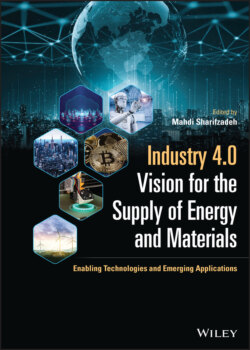Читать книгу Industry 4.0 Vision for the Supply of Energy and Materials - Группа авторов - Страница 49
1.5.4 5G Features Enhancement
ОглавлениеThe 5G cellular network provides advanced wireless connectivity for various use cases and vertical industries and paves the way for Industry 4.0. It exploits different technologies such as network slicing, network function virtualization (NFV), software defined network (SDN), and mobile edge computing (MEC) to pre-allocate resources for both communications and computing [152]. The broadband capability of 5G mobile network facilitates direct and seamless wireless communication from the field level to the cloud and enables new operating models without redesigning the production line for smart manufacturing [153]. In addition, private cellular connections could help in assigning spectrum bands and base stations such that data transmission is performed via secure and reserved channels [154, 155]. A main differentiator between 5G and previous generations of cellular networks lies in its significant emphasis on MTC and IoT. For instance, 5G air interface has enacted novel techniques in PHY and MAC layers that accommodate MTC [156]. It seems that 5G leads to convergence of the many different communication technologies as it becomes the standard wireless technology.
5G specifically focuses on supporting communication at very low latencies, unparalleled reliability, and massive IoT connectivity. Based on these distinct features in 5G networks, the emerging diversified telecommunication services are categorized into three main classes [157]: (1) ultra-reliable and low latency communications (URLLC); (2) enhanced mobile broadband (eMBB); and (3) massive machine-type communications (mMTC).
